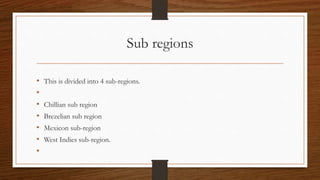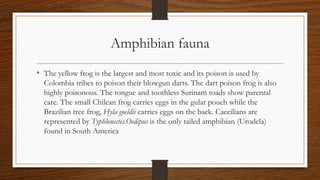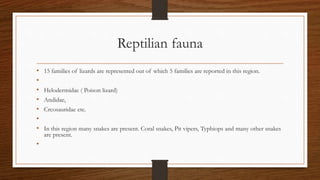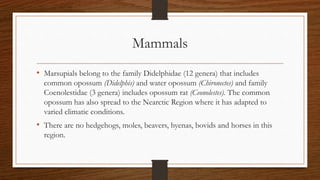Neotropical region
- 2. Neoptropical region Presented by M.Arslan rasheed Mphill scholar islamia university bahawalpur
- 3. Zoogeographical divisions This region includes south America Most of Mexico west Indies caribbean island
- 4. Boundaries • It joins the neartic region from central isthmus . • It is separated from all other regions by Atlanic ocean on eastern side of and pacific ocean on the western side
- 5. Map
- 6. Sub regions • This is divided into 4 sub-regions. • • Chillian sub region • Brezelian sub region • Mexicon sub-region • West Indies sub-region. •
- 7. Sub regions • Chillian Sub-region: It includes West Coast of South America. It contains Ands mountain ranges Bolivea, Peru, Argentina. ,. • • It includes 3 toed Ostrich called Rhea americana, Clamas, Oil birds are common. • • 2. Brazelian Sub-region: It includes tropical forests of South America. It shows evergreen forests. Plains are also seen Rivers are present hence more vegetation is seen. It supports rich fauna. in this region Amrican Monkey, Blood sucking bats (Vampire) Armadillos are common. ‘ •
- 8. Sub regions . • Mexican Sub-region: North of isthmus of Panama is called Mexkon sub- region. This region shows rocky mountains. It is showing sub. tropical conditions. in this region Tapiers, Mudterrapins etc., are common. • • 4. West Indies or Antelian Sub-region: The region contains West Indies, islands. Trinidad and Tobago are not included in this region. These islands contain mountains. In this sub-region the Vertebrate fauna is poor.
- 9. Climate conditions • This region shows tropical conditions. The southern part of South America shows temperate zones, because of these varied environmental conditions Luxuriant forests, Deserts, Plains and Rivers are common. • • In the Amazon region thick forests are present. They are all evergreen forests. • Grassy plains e present in Argentina. • This region shows Andes Mountains. Because of these conditions good vegetation is seen and rich fauna is present. •
- 10. Fish fauna • In this region many fresh water fishes are present. The important features of the regions are the absence of Carps. In this region Cat fishes; Trygonids, Edi fishes are present. • • In South American region one Dipnoi fish is present Lepidosiren is called South American Fresh water Lung fish.
- 11. Amphibian fauna • There are hylid tree frogs such as Brazilian tree frog Hyla,Hylodes, Cuban tree frog, Venezuelan tree frog that deters predators by foul odour and the poisonous Phyllomedusa found in Amazon. Leptodactylus deposits its eggs in frothy mass in holes on muddy banks of rivers and ponds and Hyla faber makes crater-like nests. The Tungara frog is noisy and makes foam nests. Tiny frogs belong to the genera Phyllobates,Dendrobates and Agalychnis
- 12. Amphibian fauna • The yellow frog is the largest and most toxic and its poison is used by Colombia tribes to poison their blowgun darts. The dart poison frog is also highly poisonous. The tongue and toothless Surinam toads show parental care. The small Chilean frog carries eggs in the gular pouch while the Brazilian tree frog, Hyla goeldii carries eggs on the back. Caecilians are represented by Typhlonectes.Oedipus is the only tailed amphibian (Urodela) found in South America
- 13. Amphibians fauna • In this zone 14 families of Amphibians are present 1) Pipa pipa • 2) Hyla • 3) Bufo • 4) Rana etc. • • Caecelians are also represented in this region 1) Siphanophis 2) Rainotrema, Urodeles are very few.
- 14. Reptilian fauna • There are plenty of snakes, iguanid lizards, Crocodilus, Caiman (alligator) and turtles. Xantusiid lizards are endemic. There are tree boas, anacondas, pit vipers and coral snakes. Mud turtles (Pelomedusidae) are shared with Africa and snake-neck turtles, Chelodina (Chelidae) with Australia
- 15. Reptilian fauna • The reptiles of the sub-region will resemble those of Ethiopian and Oriental zone. • • Crocodiles. • Alligator etc., Crocodiles are common. • • Many turtles, and Tortoises are common in this region. •
- 16. Reptilian fauna • 15 families of lizards are represented out of which 5 families are reported in this region. • • Helodermidae ( Poison lizard) • Andidae, • Crcosauridae etc. • • In this region many snakes are present. Coral snakes, Pit vipers, Typhiops and many other snakes are present. •
- 17. Birds • Almost 50% of the avian fauna is endemic and unique due to which South America is known as The Bird Continent. Out of 67 families of birds, 25 are endemic to the region. There are partridge-like tinamous, toucans that carry enormous beaks, trumpeters, hoatzin, cock of the rock (Rupicola), oil birds and several species of macaws, such as yellow macaw, Hahn’s macaw, red bellied macaw and red and blue macaw. Quail is the only member of Galliformes here. Bee hummingbird found in Cuba measures only 6 cm and is the smallest bird.
- 18. Birds • Avian fauna of this region i striking and peculiar. Hence South America is called Bird continent. (Neotropical region is referred as Bird continent). • • Rhea americana ( 3 toed ostrich) - American Ostrich • Tinamus (Flightless bird is Endemic to this region) • Ducks • Pigeons • Patrots •
- 19. Birds • Swifts • Wood peckers • King fishers • Starks are common • • Ant thrushers, Tree creepers, Oil birds are endemic to this region only. •
- 20. Mammals • There are 32 families of mammals of which 16 are unique. • Widely distributed animals are shrews, rabbits, squirrels, mice, dogs, bears, cats and deers. • Camels are represented by two species of Llama: L. vicuna and L. guanaco. Llama and Alpaca are domesticated breeds of these species. There are three species of tapirs of which one species also occurs in the Oriental Region
- 21. Mammals • Monkeys include: spider monkeys, squirrel monkeys, howlers, capuchin, marmosets which belong to families Cebidae and Hapalidae of suborder Platyrrhina. • Endemic mammals include, six-banded armadillo (Euphractus), armadillo (Dasypus), two-toed sloth (Choloepus), 3-toed sloth (Bradypus), 3 species of anteaters,(Myrmecophaga), 11 endemic families of rodent Caviomorpha and five endemic families of bats that include disc- winged bats, furipterid bats and vampire bats (Desmodontidae), the last one is also a carrier of rabies
- 22. Mammals • Marsupials belong to the family Didelphidae (12 genera) that includes common opossum (Didelphis) and water opossum (Chironectes) and family Coenolestidae (3 genera) includes opossum rat (Ceonolestes). The common opossum has also spread to the Nearctic Region where it has adapted to varied climatic conditions. • There are no hedgehogs, moles, beavers, hyenas, bovids and horses in this region.






















